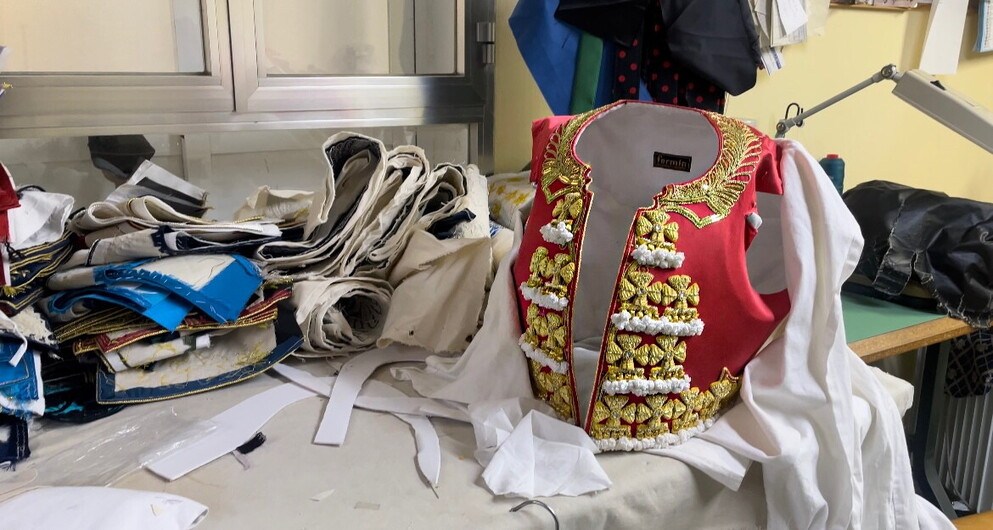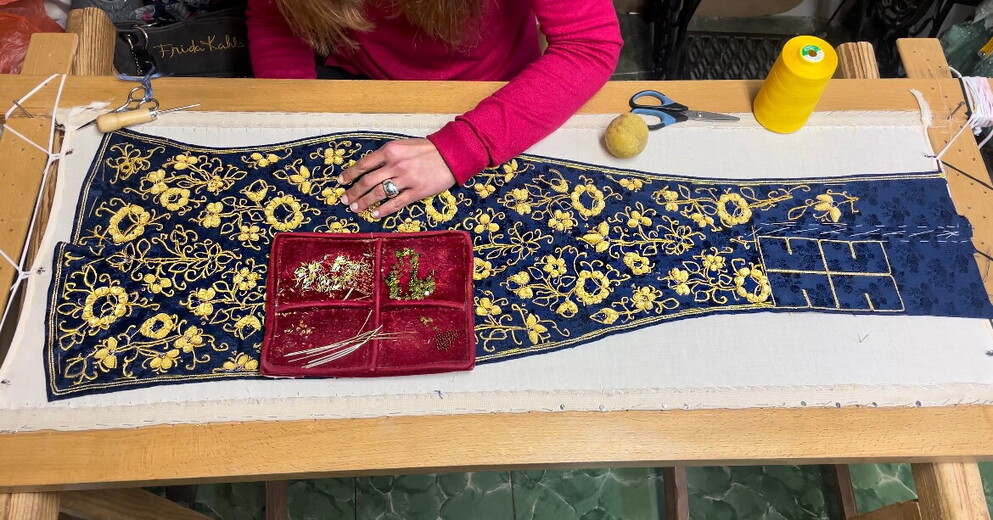Gold embroidery to dress courage. Interview with the bullfighters’ tailor
[ad_1]
To dress as a bullfighter you need: a flat black hat with two lateral peaks, called montera, a white shirt with a stiff collar and embroidered chest, a short jacket with wide shoulder straps and sleeves with gold embroidery. Also a quilted waistcoat, also in gold, a tie, narrow knee-length trousers with embroidered bands, black shoes and pink socks. Underneath, however, you need to have a steely physique and for that there are no materials, only sacrifices and effort.
On the first floor of Calle Aduana 27 in Madrid, Antonio Lopes Fuentes, the bullfighters’ tailor, has been sewing since 1963 for twelve hours a day the dresses of light, silk dresses embroidered with gold and silver, for the bullfighting elite. The bullfighting season, which began in March, will end in October and 80 percent of the shop’s produce must be ready. The shows in the arenas are many and many matadors, banderilleros and picadores to dress.
The atelier wrapped in warm boiserie does not overlook the street, almost as if it didn’t want to show itself to those who don’t understand bullfighting. “Here bullfighting dynasties are handed down, there is no normal relationship between customer and seller”, says Don Antonio, in charge of the Fermin tailoring.

The soft lights of the shop do not betray the shades of silk and brocade of the traje de luz, just wrapped in a white cloud of tissue paper and placed on the shelves, ready to be picked up. Never have clothes been so precious and significant as to dress even courage. The legendary Corriere della Sera journalist Max David, in the Volapiè book of the year 1955, described these clothes as “The most beautiful costume that has ever covered human limbs”.
Just before opening the atelier, behind the large work table and with the measuring tape around his neck, Lopes Fuentes reveals canons and tricks to create the perfect light dress “We need to enhance the merits of the bullfighter and hide his defects” says Antonio, while aligning and pulling the silk with millimeter precision. The tailor, with optical effects resolved in the design, transforms the physique of the wearer, “If they have crooked, short legs, a long torso or there are proportions to adjust, I will create embroideries of carnations, roses, leaves and birds to bring out his figure to the fullest”. Nature represented in the clothes is the constant theme, she explains.

Antonio exalts the bullfighter’s physicality, assists him, but rarely recommends the color. “The tailor doesn’t decide that, the bullfighter thinks about it meditating. In the world of bullfighting, la suerte (destiny) is everything and if I had to recommend a shade to a matador who suffers a setback… Well I would never want to be singled out because of the his misfortune”.
Of course Antonio has preferences. “There are clothes that are specially created to match the atmosphere of the arena. The most beautiful? For me red, which goes very well with gold and is a combat, gladiator color. Which ones do I like least? The blues, very elegant, but without force. The gold stands out against the navy blue or the dark green, with the embroideries of light it is magnificent”. Lopes Fuentes reaches out and takes a piece of moss-colored silk from the shelf and unrolls it on the table.
The bell rings, customers come in and wait seated on comfortable leather armchairs, the men of the quadrille, the matador teams. They came to collect their clothes to fight in the afternoon, at 5 in the evening, as the poet Garcia Lorca wrote. A banderillero also arrives, he has in his arms the orange trousers of the traje de luz to be stitched up after the blows suffered by scalpel-sharp horns, “God only gave me two hands, it will take me some time to fix it”. The two say goodbye and on to the next customer.

He arrives with a brisk step, he’s a matador, he heads down the corridor to the fitting room, the most intimate room in the atelier. The large mirror doubles the deco beauty of the chairs and the chandelier, the atmosphere is muffled if it weren’t for the blood-red carpet that reminds him that there is no joking around.
It happens that bullfighters enjoy themselves during the rehearsal of the traje de luz and laughter can be heard from afar. They guard against daring daffodils, suerte hovers, we might as well stay light, in the end only she decides.
Behind a small door, here is the laboratory. The hands of many embroiderers in white coats draw with the needle. It is the heart of the atelier, where the dress lights up. Embroidery has something to do with devotion. “Taurine tailoring schools hardly exist anymore, Antonio taught us everything”says one of them inserting the trimmings that enrich the dress, making it massive.

The bullfighter, wearing the traje de luz, weighs almost twenty kilos more on the scales, losing agility without benefiting from protection and Lopes Fuentes himself confesses that “Moving in the dress is difficult, but when a six hundred kilo bull starts charging towards the matador… the last thing one thinks about is whether it’s comfortable”, a paradox for the acrobatic art of bullfighting. The absurd beauty goes on stage and there are thousands of rites that accompany the dressing among the comments from the waiting room: “My matador, before a bullfight, always tries on the dress in front of six people”. “You can’t look at this, the bullfighter doesn’t want to”, says a boy putting his salmon pink jacket with gold embroidery back into the bag.
Having a traje de luz from the Fermin house is a dream that doesn’t always come true, especially for little known young people who, not being able to afford them, rent them in village shops for the afternoon in which they have to fight, and woe to break them, they should pay it back. There are those who are lucky enough to ring the bell on Calle Aduana 27 in Madrid and Antonio, from behind his glasses, will scrutinize and divine the wishes of his customers.
“You don’t have time to finish a dress of light and I have to start another,” she laments. Since 1963 there have been many bullfighting seasons that have brought his costumes to triumph and haste does not seem to bother him because between him and the customer there is always la suerte. She enters the atelier without knocking, she is everywhere, she is a shadow hiding among the brightest colored silks, she has been seen many times in the Arena becoming a fatal gust of wind. “A matador’s worst enemy,” says Lopes Fuentes, “because he moves the muleta, the red flannel drape that is the bullfighter’s weapon and shield.”
Sometimes the suerte is sitting in the audience, on the steps of the ancient Roman arenas, also enchanted by the divine light of that ray of sunshine that touches Antonio’s gold embroidery and turns her into good luck.
[ad_2]
Source link











